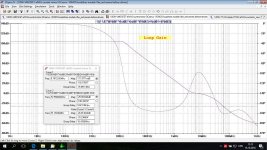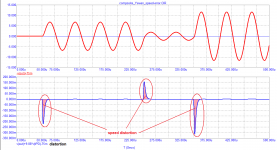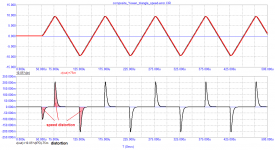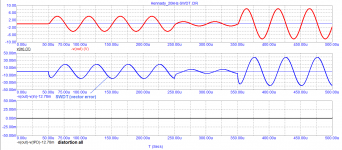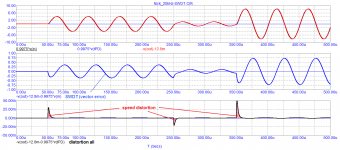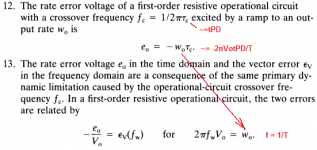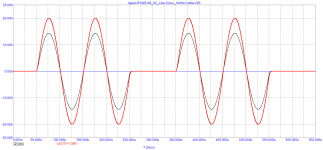Is this enough loop gain at 20kHz?in fact, many have a different understanding of this very quality. The figure 60dB is not taken from the ceiling, with a single-stage topology, the maximum gain rarely exceeds 90dB, minus the gain of 24-26dB and 4-6dB of losses used for gain linearity, it remains just 60dB, This value can be less if the gain is linear in the audio frequency band up to negative feedback coverage.
With a two-stage topology, it is theoretically possible to obtain a gain of 180 dB, but in fact, it is very difficult to obtain a gain of more than 110 dB without lowering the pole, because the unity gain frequency is already striving to jump beyond the frequency of 10 MHz, i.e. limit of the technological possibility of the radio amateur level.
also with increasing gain, it is necessary to correct with circuits of higher orders, for the first order of correction, which I very often see in your models, you can forget - its problem at a certain depth at a frequency of 20kHz, at which the pole cannot be higher than 20kHz, or it will be an amplifier with very low gain (45-55db) to negative feedback coverage.
super high quality - this is a negative feedback depth of at least 90db at a frequency of 20kHz. Will there be a high quality amplifier with 70dB negative feedback at 20kHz? yes, it will.
Attachments
Hennady, I have to upset you, here are the distortions introduced by such an amplifier at a frequency of 10 kHzWill there be a high quality amplifier with 70dB negative feedback at 20kHz? yes, it will.
Attachments
I think you do not read my posts or are not able to understand the meaning, since you do not see the difference between the accuracy of the calculation and a fundamental error in the presentation of the material and the derivation of formulas. I will refuse your offer to do calculations, because it will not lead to any result anyway, except for the useless waste of my time. In total, I will not tell you anything more on this issue, do as you see fit, and other participants will see my information and will be able to evaluate it themselves.fagos, well, calculate with cosmic accuracy according to the refined formulas what it (tPD) should be (262)
Regarding the composite amplifier by Yewen - where the input function breaks - there are your mythical "speed distortions". Nothing new, you can just as well give a rectangular signal and use it to predict the sound quality "according to Petrov's criteria"
...and other participants will see my information and will be able to evaluate it themselves.
If you have seen your version of the formula in the book Jiri Dostal, then give the number of the formula or page, I did not find it.
As a separate question, I can cite a curious drawing from the book that I would like to show you and ask for a comment on this. As you understand, in the context of your theory, I got the statements in the caption to the drawing. Since the drawing is from the Russian-language version (fig.3), then for the English-speaking audience I bring in addition the same one from the English-language edition (fig.4).
I will explain why I ask the question - the vector error at the F1 frequency will decrease, but petr-2009 shows us on the contrary an increase in the vector error with an increase in the depth of feedback. Got's statements correspond to the classical theory, and petr_2009, referring to him, contradicts him. It turns out some kind of incident that requires resolution and clarification.
Here are the arguments:
I explain on a specific example of an amplifier from a competition in which about 10 contestants took part. I took only two versions of the amplifier correction.
In one case, the simplest single-pole correction was applied, while the group delay time is only 37 ns and there are no high-speed distortions from the word at all.
In the second case, a multi-pole equalization was applied, which increased the loop gain by almost 60 dB! As you can see, the group delay time of the signal has increased to 700 ns (almost 20 times).
Learn formulas!
Attachments
-
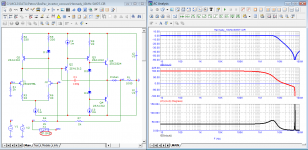 01_Hennady_Bode.png31 KB · Views: 103
01_Hennady_Bode.png31 KB · Views: 103 -
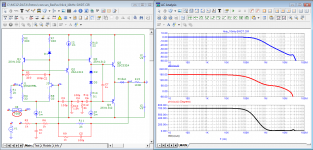 01_Nick_Bode.png32.5 KB · Views: 108
01_Nick_Bode.png32.5 KB · Views: 108 -
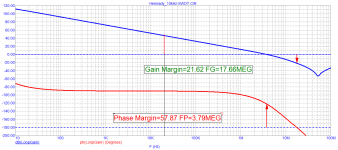 02_Hennady_Loop-Gain.png14.1 KB · Views: 102
02_Hennady_Loop-Gain.png14.1 KB · Views: 102 -
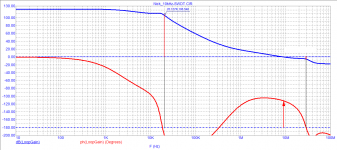 02_Nick_Loop-Gain.png12.6 KB · Views: 100
02_Nick_Loop-Gain.png12.6 KB · Views: 100 -
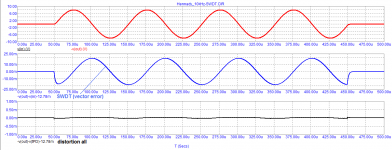 03_Hennady_10kHz-SWDT.png12.2 KB · Views: 95
03_Hennady_10kHz-SWDT.png12.2 KB · Views: 95 -
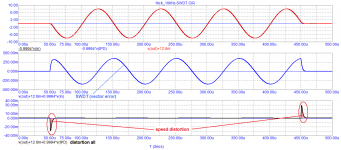 03_Nick_10kHz-SWDT.png16.9 KB · Views: 94
03_Nick_10kHz-SWDT.png16.9 KB · Views: 94 -
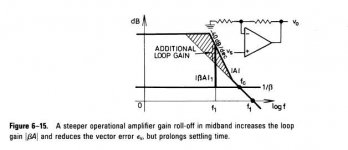 Fig4.JPG21.3 KB · Views: 84
Fig4.JPG21.3 KB · Views: 84 -
 Dostal_en.png24.9 KB · Views: 98
Dostal_en.png24.9 KB · Views: 98
petr_2009, with age, cognitive functions tend to fade. A large number of people tell you where to look, but you persistently do not see the moon, looking at your finger. Even in the results you have given, it can be seen that an error in a system with a larger feedback value has a smaller error in the operating frequency range - the line is completely smooth. In the second variant, there are no bursts at the beginning of the burst, but the error is greater - the undulation is visible. Since we are not bats, we are concerned about an error in the working audio frequency range, and not beyond it. In addition, he got it right says - the installation time will increase, but the error will decrease. This happens when you read the source, but there is not enough understanding to realize what the author said. Sorry.
And about the formulas... your fragment does not contradict my formula in any way and does not prove you right, so save the pathos for someone else.
And about the formulas... your fragment does not contradict my formula in any way and does not prove you right, so save the pathos for someone else.
petr_2009, with age, cognitive functions tend to fade. A large number of people tell you where to look, but you persistently do not see the moon, looking at your finger. Even in the results you have given, it can be seen that an error in a system with a larger feedback value has a smaller error in the operating frequency range - the line is completely smooth. In the second variant, there are no bursts at the beginning of the burst, but the error is greater - the undulation is visible. Since we are not bats, we are concerned about an error in the working audio frequency range, and not beyond it. In addition, he got it right says - the installation time will increase, but the error will decrease. This happens when you read the source, but there is not enough understanding to realize what the author said. Sorry.
And about the formulas... your fragment does not contradict my formula in any way and does not prove you right, so save the pathos for someone else.
This is my first time encountering a professional troll. He really looks at the moon, but he sees only a finger.
In the first case, the amplifier is broadband, the phase and group delay of the signal are linear up to almost 1 MHz, the gain at the testing frequency is 1, there is no amplitude distortion!
In the second case, the amplifier is less broadband and already at a testing frequency of 10 kHz has amplitude distortion. Therefore, in order to equalize the voltages during subtraction, it was necessary to apply a multiplier of 0.9994 instead of 1 for the input signal. The amplitude error is 0.06%.
In accordance with Jiri Dostal's calculations, in order to obtain an amplitude error of 0.01%, the bandwidth should be 71f = 710 kHz.
So that you do not see any irregularities there, I present graphs on the same scale.
As for what people hear.
Indeed, people hear differently. Some even hear colors, others see sounds in colors (due to the close passage of the auditory and optic nerves). The fact that most people perceive sounds up to several hundred kHz is proven by modern psychoacoustics. Here is what Charles Hansen, founder of Ayre Acoustics, wrote about amplifiers with feedback:
“Regarding the use of feedback in audio circuitry, we already know that it does not work as advertised. The idea is that the output of the circuit is compared to the input signal. Any differences at all (noise or distortion of any type) is subtracted from the incoming signal. But if this process worked properly, then all amplifiers would sound identical as they would all be reproducing the input signal perfectly.
Unfortunately reality is somewhat more messy than is theory. In reality every amplifier sounds different from each other. Applying negative feedback does not help this in any way whatsoever.
There is at least as much variance between the sounds of amplifiers employing feedback as those that do not. In fact, taken as a whole, our experience is that zero-feedback amplifiers tend to sound more similar to each other than typical feedback-type amplifiers.
A far better approach is to simply design a circuit that is inherently linear, to the point where the distortion contribution from the amplifier is well (eg, 10x) below the distortion contributed by the loudspeakers. When this condition is met, there is no reason to apply feedback. Anyone who becomes familiar with the sound of zero-feedback amplifiers will find it difficult to return to conventional designs.”
So what level of distortion introduced by the amplifier is sufficient so that the distortion is not felt by a person? Let's say the distortion introduced by the acoustic system is 2%. Then the amplifier is required that its distortion does not exceed 0.2%. This is exactly what reference tube amplifiers and solid state amplifiers without negative feedback prove.
Amplifiers with deep NFB most often sound lifeless, kill microdynamics. The level of high-speed distortion just characterizes the loss of microdynamics.
Attachments
At a frequency of 20 kHz in an amplifier with multi-pole correction, the situation is even worse - the amplitude error is already 0.25%! the vector errors also increased by a factor of 2.
Here's what Nelson Pass, another proponent of non-FB amplifiers, has to say about negative feedback amplifiers:
«The last ten years have once again demonstrated that high-end amplifiers with part-per-million distortion numbers and other superlative specifications are not very popular. It's like pure distilled
water-it has no character and most people don't want to drink it.»
Here's what Nelson Pass, another proponent of non-FB amplifiers, has to say about negative feedback amplifiers:
«The last ten years have once again demonstrated that high-end amplifiers with part-per-million distortion numbers and other superlative specifications are not very popular. It's like pure distilled
water-it has no character and most people don't want to drink it.»
Attachments
Last edited:
Here's what Nelson Pass, another proponent of non-FB amplifiers, has to say about negative feedback amplifiers:
«The last ten years have once again demonstrated that high-end amplifiers with part-per-million distortion numbers and other superlative specifications are not very popular. It's like pure distilled
water-it has no character and most people don't want to drink it.»
I am very disappointed if Nelson Pass really said that.
To make good plum brandy you have to do double distillation up to, let say, 60% of alcohol, and then deluded it with pure distilled water, not with some kind of mineral water or similar, and change the taste .
We can say that is analogy to the music production (plum brandy) and reproduction(pure distilled water).
«The last ten years have once again demonstrated that high-end amplifiers with part-per-million distortion numbers and other superlative specifications are not very popular. It's like pure distilled
water-it has no character and most people don't want to drink it.»
I am very disappointed if Nelson Pass really said that.
To make good plum brandy you have to do double distillation up to, let say, 60% of alcohol, and then deluded it with pure distilled water, not with some kind of mineral water or similar, and change the taste .
We can say that is analogy to the music production (plum brandy) and reproduction(pure distilled water).
you asked me about the value of feedback, and my answer is true, the fact that you put other parameters only says that the quality is determined by a set of parameters.Hennady, I have to upset you, here are the distortions introduced by such an amplifier at a frequency of 10 kHz
your understanding of high-speed distortion is another nonsense that has a very indirect relation to the required value of the feedback depth in a power amplifier ...
not all amplifier topologies can make the function group delay GD minimal, but this does not mean that such amplifiers will sound.
An example of a high-order correction by guru Nick is another confirmation of this - I would not recommend such a correction topology to anyone. The order of correction is determined by the number of highohms points in the topology of the amplifier, hence we proceed, i.e. the order of correction is determined by the sum of the chains of the first and zero orders, as in systems of variable states, and not as in sound correctors like Nick.
Last edited:
Saying and doing are not the same. Pass has been making negative feedback amplifiers all his life and continues to do that he manages to correct them with a zero-order circuit - this is probably cool and practically does not affect the comfort of the sound. However, if we need super super linear amplifiers, higher orders of depth and correction are indispensable...I am very disappointed if Nelson Pass really said that.
You put it wrong. It was necessary: "This is my first performance as a professional troll"This is my first time encountering a professional troll.
And some see speed distortions. But specialists in the field of psychiatry are trying to help everyone, despite the deviations they have. And yet, how should perception anomalies affect a mass product and why are these links marketing articles without evidence and scientific data? With all due respect, Mr. Hanson's task now is to justify the uniqueness of his products and promote them on the market to ensure profit, and not to teach the whole world how to design amplifiers correctly.However, you again don't see the difference...As for what people hear.
Indeed, people hear differently. Some even hear colors, others see sounds in colors (due to the close passage of the auditory and optic nerves). The fact that most people perceive sounds up to several hundred kHz is proven by modern psychoacoustics.
Which specific amplifiers with large loop amplification have you personally heard? What was their feedback depth at 20kHz? On what acoustics was the listening conducted?Amplifiers with deep NFB most often sound lifeless, kill microdynamics. The level of high-speed distortion just characterizes the loss of microdynamics.
The opinions of other people who have actually listened to amplifiers with a feedback depth of 90dB or more are directly opposite to your words, but are consistent with classical scientific foundations. It seems to hint that empty words on your part are not enough to turn the river back.
About your comparison of Hennady and Nick frequency compensation methods... You forget that the purpose of this competition was educational and laboratory - to adjust with maximum preservation of gain at 10 kHz. Not to build the best amplifier, but to perform the action according to the task.
In addition, your graphs cannot be checked, but at the same time any error in compensation will give a sinusoidal difference wave. Since we do not see what happens during the storm in detail, there is nothing to discuss here.
Parallel current feedback circuit
Attachments
-
 1 Parallel current feedback circuit.jpg276.5 KB · Views: 203
1 Parallel current feedback circuit.jpg276.5 KB · Views: 203 -
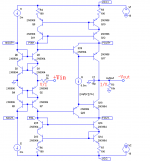 2 Parallel current feedback circuit.png38.6 KB · Views: 191
2 Parallel current feedback circuit.png38.6 KB · Views: 191 -
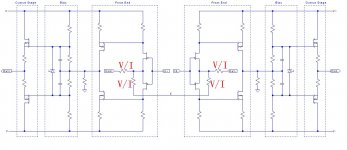 3 Parallel current feedback circuit.jpg109.5 KB · Views: 177
3 Parallel current feedback circuit.jpg109.5 KB · Views: 177 -
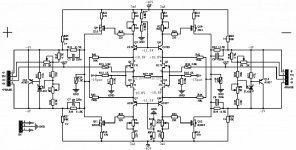 4 Parallel current feedback circuit.jpg228 KB · Views: 187
4 Parallel current feedback circuit.jpg228 KB · Views: 187 -
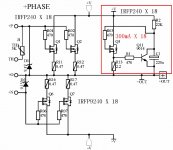 5 Parallel current feedback circuit.jpg104.8 KB · Views: 169
5 Parallel current feedback circuit.jpg104.8 KB · Views: 169 -
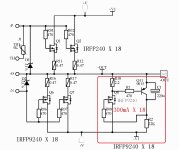 6 Parallel current feedback circuit.jpg105.6 KB · Views: 164
6 Parallel current feedback circuit.jpg105.6 KB · Views: 164 -
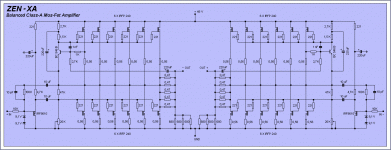 zen-XA.gif23.8 KB · Views: 176
zen-XA.gif23.8 KB · Views: 176
Here's what Nelson Pass, another proponent of non-FB amplifiers, has to say about negative feedback amplifiers:
«The last ten years have once again demonstrated that high-end amplifiers with part-per-million distortion numbers and other superlative specifications are not very popular. It's like pure distilled
water-it has no character and most people don't want to drink it.»
I am very disappointed if Nelson Pass really said that.
To make good plum brandy you have to do double distillation up to, let say, 60% of alcohol, and then deluded it with pure distilled water, not with some kind of mineral water or similar, and change the taste .
We can say that is analogy to the music production (plum brandy) and reproduction(pure distilled water).
Dadod, extremely unfortunate comparison.
Is it possible to compare the taste of a cucumber from the garden with a cucumber from a tin can? What water you don’t preserve (at least on distilled water), you won’t get the taste of cucumber from the garden.
Here we are talking about amplifiers - this is only part of the process of preserving the final product - music.
It is enough to listen to the performer's voice live, and then through a microphone, amplifier and acoustics to understand that this is heaven and earth, not to mention making a recording and then playing it back.
Here is an example of how a feedback amplifier works. The colleague was just trying to show that there was a problem.
https://www.diyaudio.com/community/threads/musings-on-amp-design-a-thread-split.366099/post-6519124
Can you tell me what is wrong with this amp? If yes, in what?
Attachments
Sorry, but you did not get it.Dadod, extremely unfortunate comparison.
Is it possible to compare the taste of a cucumber from the garden with a cucumber from a tin can? What water you don’t preserve (at least on distilled water), you won’t get the taste of cucumber from the garden.
Here we are talking about amplifiers - this is only part of the process of preserving the final product - music.
It is enough to listen to the performer's voice live, and then through a microphone, amplifier and acoustics to understand that this is heaven and earth, not to mention making a recording and then playing it back.
Here is an example of how a feedback amplifier works. The colleague was just trying to show that there was a problem.
https://www.diyaudio.com/community/threads/musings-on-amp-design-a-thread-split.366099/post-6519124
Can you tell me what is wrong with this amp? If yes, in what?
Sorry, but you did not get it.
Dadod, if you're talking about water, then I can give another example where exactly water has a major role as a product.
In 1975, I was a member of the delegation for the exchange of experience at the Lida Brewery (Belarus, the city of Lida). At that time, the old brewing technology was still used at the plant. The brewery organized a tasting of more than 10 samples of beer from different breweries.
The winner was a sample of the Lida plant with a large margin from the rest of the samples. I asked the technologist of the plant: what is the secret of such high quality?
It turns out that the water on which the wort is brewed is of great importance for beer. The plant has its own well from which they take water for the technical process. The composition of trace elements is important, which ultimately determines the taste of beer.
There were cases of failure of the submersible pump and the plant was forced to switch to water from the city network, the quality of beer immediately deteriorated.
What about the question about the Cortez test?
What do you think is the reason for such a work of the amplifier? And what do you think, is such work on acoustics acceptable?
Last edited:
You still don't get it.Dadod, if you're talking about water, then I can give another example where exactly water has a major role as a product.
In 1975, I was a member of the delegation for the exchange of experience at the Lida Brewery (Belarus, the city of Lida). At that time, the old brewing technology was still used at the plant. The brewery organized a tasting of more than 10 samples of beer from different breweries.
The winner was a sample of the Lida plant with a large margin from the rest of the samples. I asked the technologist of the plant: what is the secret of such high quality?
It turns out that the water on which the wort is brewed is of great importance for beer. The plant has its own well from which they take water for the technical process. The composition of trace elements is important, which ultimately determines the taste of beer.
There were cases of failure of the submersible pump and the plant was forced to switch to water from the city network, the quality of beer immediately deteriorated.
What about the question about the Cortez test?
What do you think is the reason for such a work of the amplifier? And what do you think, is such work on acoustics acceptable?
More than 15 years ago, Graham Maynard raised the issue of the correlation of first period distortion (FCD) with sound quality. This issue was discussed in two threads (maybe somewhere else, I don't know) and his attempts to prove anything were powerless. Theorists translated everything into distortions of the first period of RC elements, which Sandy also tried to do. Moreover, Graham tried to prove the detrimental effect of inductance at the amplifier output. Of all the colleagues participating in the discussion of the problems, only the esteemed John Curl supported Graham: “stay the course, Graham!”
It is felt that Cortez is related to the development of audio amplifiers and understands what he is talking about:
«I'd say transient distortion is a one that's not continuous/periodic and is only present right at the beginning (or at the end) of the change.
I know these are extreme cases but besides that they represent that there is some "special" error at every "new" signal change which cease after a few periods.»
I have repeatedly pointed out that this kind of distortion occurs whenever the signal deviates from the steady state: when the signal amplitude or frequency changes.
Let's perform a Cortez test with the first model that caught our eye containing an inductance at the output, for example, on the Cherry amplifier model
Isn't it true, the result is almost one to one.
It is felt that Cortez is related to the development of audio amplifiers and understands what he is talking about:
«I'd say transient distortion is a one that's not continuous/periodic and is only present right at the beginning (or at the end) of the change.
I know these are extreme cases but besides that they represent that there is some "special" error at every "new" signal change which cease after a few periods.»
I have repeatedly pointed out that this kind of distortion occurs whenever the signal deviates from the steady state: when the signal amplitude or frequency changes.
Let's perform a Cortez test with the first model that caught our eye containing an inductance at the output, for example, on the Cherry amplifier model
Isn't it true, the result is almost one to one.
Attachments
- Home
- Amplifiers
- Solid State
- Apex A40 fundamental improvement. (Sandy)
